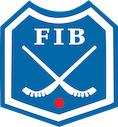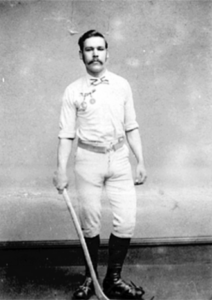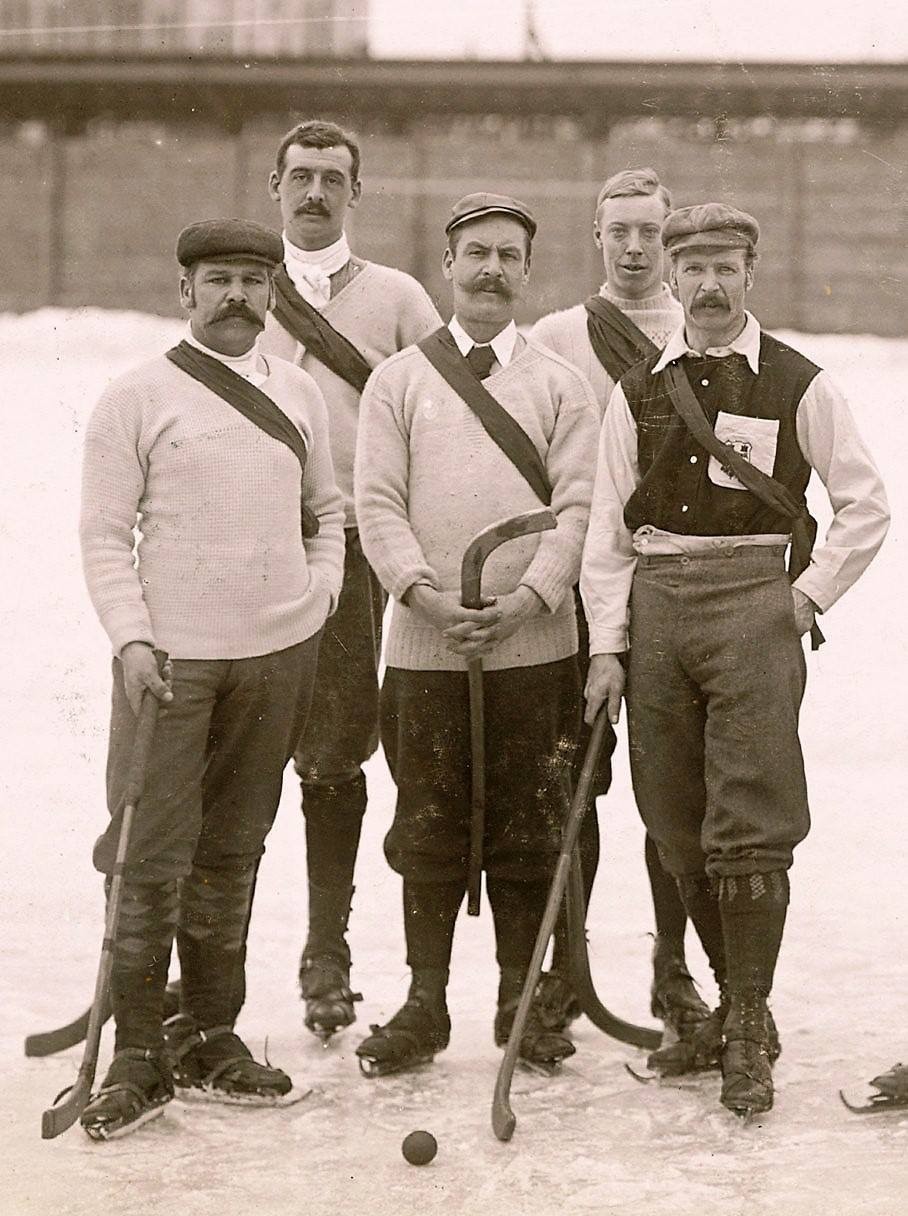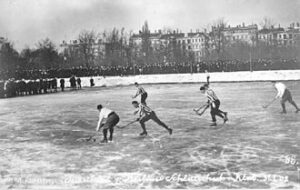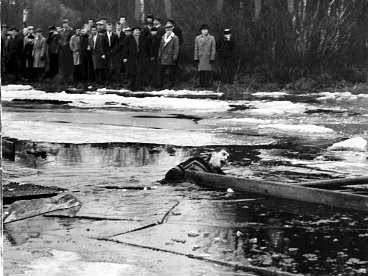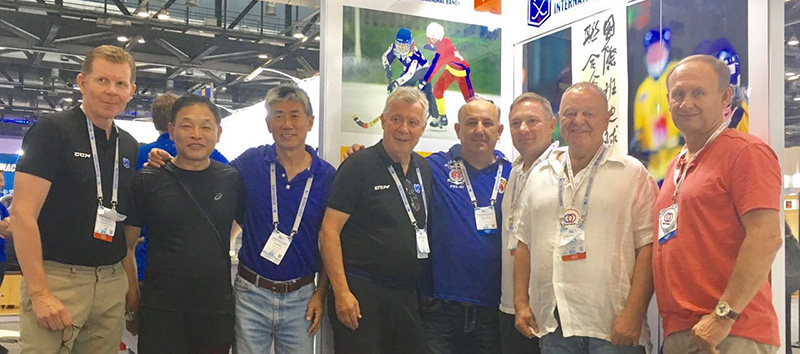To put the Federation of International Bandy into the big perspective of bandy, we need to take you into a journey that started in a tomb that was built at Beni Hasan, the ancient Egyptian cemetery. It is located in the Nile Valley, approximately 20 kilometers south of the Minya City in the region known as Middle Egypt. The distance to Cairo up north is about 200 kilometers
Some traces and remains showing the existence of the ancestors of our players today are mainly to be found in Iran (ex-Persia), Egypt and Greece. As long as 2 000 B.C. the tomb was built at Beni Hasan. On the wall of this tomb there is a drawing picturing two players with sticks starting a game with a ball. The first historical signs of our sport are then carried on land and a long time would elapse before taking advance of the ice.
Also, the Greeks gave us evidence of our sport. A more recent fresco from about 500 B.C. shows six players in what is the same movement of starting a game. After that, it is remarkable, that the next known picture of a bent stick game does not appear until about year 1200 in the Canterbury Cathedral.
1891
THE MODERN FORM OF BANDY WAS CREATED IN ENGLAND
As organized sport, bandy first appeared in England. National Bandy Association was the first English governing body for the team winter sport of bandy, and actually the first bandy governing body anywhere in the world. The association was founded in 1891.
The first general rules were written down by Charles Goodman Tebbutt in Bury Fen Bandy Club in 1882 and by the corresponding body in USSR. The first international bandy match took place in 1891 between Bury Fen Bandy Club from England and the Haarlemsche Hockey & Bandy Club from the Netherlands. The Dutch club, which after a couple of club fusions, now is named HC Bloemendaal. Bloemendaal developed into an extremely successful club even in modern times.
Bandy was a popular sport in England until the first World War, and the England national bandy team won the 1913 European Bandy Championships, but then the English lost interest in the sport and the National Bandy Association was discontinued. Bandy got official status in the Soviet Union in 1898, in Norway 1903, in Sweden 1907, in Finland 1908 and started developing widely in Europe after that.
1908
THE LIGUE INTERNATIONAL DE HOCKEY SUR GLACE WAS FOUNDED
On 15 May 1908 at 34 Rue de Provence in Paris, France the organization was born. This was at a time when bandy and ice hockey were seen as variants of the same game. The founders of the federation were representatives from Belgium, France, Great Britain, Switzerland and Bohemia (now Czech Republic).
1910
THE NORTHERN BANDY UNION WAS FOUNDED
It is naturally that this process finished with successful foundation in 1910 of Northern Bandy Union including Sweden, Norway, Denmark, Germany and Soviet Union. Later joined Belgium, Italy, Holland, France, Switzerland and England.
1940
THE NORDIC COUNTRIES SET UP COMMON RULES
As ice hockey became an Olympic sport while bandy did not, bandy only survived in some of the Nordic countries and the Soviet Union. LIHG is now the International Ice Hockey Federation (IIHF). In the 1940s, the Nordic countries Finland, Norway and Sweden set up a joint rules committee.
1952
BANDY DURING THE OLYMPIC GAMES IN OSLO
The background for the Winter Games in Oslo 1952 was quite peculiar. It was not an expressed wish from the various Norwegian winter sports federations to arrange these games, but it was purely a political idea from the beginning and through to the final decision!
The idea came up during tragic circumstances in a Nazi-concentration camp called Sachsenhausen in Germany during World War II, where several Norwegian politicians had been incarcerated because of their opposition to Nazi-Germany’s occupation of Norway. Amongst them were a future Prime Minister of Norway, a future Deputy Mayor of Oslo, a future Cabinet member and an already known architect.
Right after the war ended in 1945 these people came back to Norway and almost immediately decided to try to get the Winter Olympics 1952 to Oslo and started to promote the idea in the political system. The 1948 Games was excluded for financial reasons after the war. In August 1946, Oslo’s politicians decided to apply to the IOC to get the games in 1952. The application was supported by Mr. Thomas Fearnley, then a Norwegian Board Member in IOC. As the story goes, the political process and the decision were without any real debates, but perhaps the most unusual part of it was that the application to the IOC was sent without much interest having been shown by the Norwegian winter sports’ federations. And it was decided that, if Oslo got the Games, the architect from the Nazi-concentration camp’s idea sessions should get the job of designing the various arenas. And so, it happened!
At the time the IOC required that a sport that wanted to participate in the Olympics had an international federation behind it. Bandy did not have that until the International Bandy Federation, IBF, was established in 1955. However, an international bandy rules committee was put together in 1949 by Sweden, Finland and Norway. An exception for not having a federation were a few bandy games in 1928 in the first Winter Spartakiade ever. That took place in Oslo between socialist teams from Norway, Sweden and Soviet.
Oslo was awarded the Games
At the IOC Congress in Stockholm in 1947, the Organization for the 1952 Olympics was established under the chairmanship of Mr. Olaf Ditlev-Simonsen, who had replaced Mr. Fearnley as the Norwegian delegate to the IOC. Mr. Ditlev-Simonsen was amongst a lot of things, a former bandy player with several Norwegian championships and national team appearances in his CV. It is undoubtedly due to his efforts, possibly in good cooperation with the IOC’s Chairman Mr. Sigfrid Edström from Sweden, that bandy was elected to be a Demonstration Sport. That was the first and so far, only time on senior level (later Youth Olympics 2016 Lillehammer/Gjøvik and Lausanne 2020).
The Games were opened on Friday, 15 February, 1952, at the then famous speed-skating arena Bislett by Mr. Ditlev-Simonsen and HRH Princess Ragnhild, a substitute for her grandfather King Haakon VII and her father Crown Prince Olav who were in London for the funeral of King George VI.
The bandy demonstration were to be played in three games between Norway, Sweden and Finland. Soviet, which had at the time participated in some sporting events abroad, had been invited to participate in the bandy demonstration games, but did not for administrative reasons. An interesting explanation has come from a Russian historian, Sergey Shapovalov:
Soviet athletes had been preparing for the Oslo Olympic Games because Stalin had made a political decision to firmly and clearly get out of sports isolation. The participation later in 1952 in the Summer Olympics in Helsinki confirms this. However, the Soviet sports officials forgot to apply for participation in the Oslo games in time. At that time, the Russians did not have any experience in protocol matters, but they took a lesson and did it in time for the Summer Games.
The Olympic Bandy Demonstration Tournament in 1952
Although not part of the ordinary Olympic Games, was listed in the official Olympic Program alongside the other events:
Norway met Finland in the first game on Wednesday 20 February at Dælenengen Arena in Oslo. In the middle of the day around 500 people attended, amongst them the IOC Vice chairman Mr. Avery Brundage. After 13 minutes Norway had scored 2 goals, and it took the Finnish players 35 minutes to hit the goal’s net. However, they followed up with an equalizer three minutes later and added a third goal in the second half to win 3-2.
Norway met Sweden already the day after in the same arena. After that game the headline in the biggest Norwegian daily read “Norwegian bandy’s greatest day”, as they defeated the more famous Swedes 2-1. Norway’s first win in history over Sweden. 3000 people were in the audience, and with the Swedish Prince Bertil in one of the VIP-chairs. The spectators, among them many Swedes, asked themselves after the first half whether the Norwegians could keep up the good play in the second half. They did!
Sweden and Finland played on Saturday, 23 February, the last and decisive game of the Olympic Demonstration Bandy Tournament in Bislett Stadium in the city center, with around 1500 people in the stands. To win the tournament, the Swedes had to beat the Finns with at least two goals. Sweden scored four goals, Finland none.
The bandy demonstration games got relatively good coverage in the newspapers, especially in the Oslo papers, although the competition for the newspapers’ space and the journalists’ time were of course tremendous from the ordinary Olympic events. Anyway, the biggest Norwegian daily, Aftenposten, nominated an All Star Team after the games.
1954
THE BREAKTHROUGH FOR MODERN INTERNATIONAL BANDY
In the early 1950s, the Soviet Union decided to break out of its isolation in international sport and started a friendly exchange with the Nordic countries. Previous futile efforts to get into contact with the Soviet bandy stimulated the head troika of the Swedish Bandy Association Gunnar Galin, Börje Tegfors and Lage Gadde to strike out new paths to gain a hearing from the Sports Committee in Moscow.
Gunnar Galin:
–We interested the Finnish Football Association which also administered the bandy sport in influencing through their soccer channels the plans for a meeting with the Soviet Bandy Board. John Gustafsson, the Finnish Secretary General, started lobbying the Soviet Embassy in Helsinki at the same time as Borje Tegfors, the Swedish Secretary, tackled the Soviet Embassy in Stockholm.
–Both reported that our views had been met with sympathy and we thought that we were in a fair way to get a bandy federation. After a visit to Finland John (Gustafsson) and I had agreed to arrange a meeting in Helsinki for this purpose. About at the same time the Soviet Union invited all the bandy nations‘ teams plus leaders to Moscow. The invitation was very generous, free train return tickets and free board and lodging. We were promised to get an opportunity of demonstrating our game and the Soviet theirs at the Dynamo Stadium. The games were equal in many respects.
–At the small social gathering after the matches we were not surprised that the Russian chief delegate Juri Basjanov knew our rules in detail. He frankly declared that the Soviet Union was prepared to accept the Scandinavian game provided that a border was added to the rules. We thought that this was a modest request and accepted without any hesitation, concludes Gunnar Galin.
The leaders of these four nations then spoke of forming a Federation and a preparatory meeting was held in Helsinki on 4-5 September 1954. The idea to set up an international federation was proposed by Soviet but was considered too pretentious by the rest of the delegates at this time. One pursued a wait-and-see policy.
At the following meeting the question of a federation was taken up again. Soviet persisted and Sweden, avoiding complicating the issue, voted for a federation. This was the prelude to establish the International Bandy Federation (IBF).
1955
FINALLY – THE BIRTH OF THE INTERNATIONAL BANDY FEDERATION!
The time was 10.20 on Saturday, 12 February 1955 – The birth of the International Bandy Federation. The place was Hotel Malmen in Stockholm. Extracts from the minutes kept at the International Bandy Conference in Stockholm.
The conference delegates

Gunnar Galin, FIB first President
Jens Raanaas, Eigil Sorlie and Kaare Nordby from The Norwegian Bandy Association. Leo Suurla, John Gustafsson, A. Ljungkvist and S. Salo from The Finnish Ball Association, Michail Kanunnikov, Juri Basjanov and Michail Koslov from the Soviet Union, Gunnar Galin and Borje Tegfors from the Swedish Bandy Association. Markus Aure, Finland, acted as an interpreter. Signatories for the founding document were L.I. Suurla, Finland, Jens Raanaas, Norway, Michail Kanunnikov, Soviet Union and Gunnar Galin, Sweden.
§ 4 The establishment of an International Bandy Federation
It was decided unanimously to establish an International Bandy Federation. The decision was confirmed by the chairman at 10.20. A document confirming this decision was to be signed on February 14, 1955.
§ 5 The name and the charter of the Federation
It was decided that the name of the new Federation would be The International Bandy Federation (IBF), translated to the respective language of the participating countries.
Gunnar Galin was elected to be the first President, and he chose his own Swedish Federation Secretary, Börje Tegfors, as Secretary. At the initial Congress, common rules were accepted and already at the Moscow tournament, the Soviet representatives insured that the Nordic countries gave approval to the boards on the sides of the ice that they had already adopted. And so, it was. At the same time, the Soviets accepted the somewhat more flexible Swedish bandy sticks. When FIB was formed in 1955, it introduced the same rules for bandy all over the world, with minor differences in the various member nations.
Also, on the agenda stood a proposal to institute a Championship competition. And we are many bandy lovers that appreciate that proposal.
1957
THE FIRST WORLD CHAMPIONSHIP TOURNAMENT!
The first ever World Championship bandy match was played Thursday, 28 February 1957, at Helsinki Olympic Stadium. It was an encounter between historical antagonists Finland and Sweden, and it was a dramatic and uncertain battle. The Swedes held the lead twice in the half snow-covered arena, but the Finns succeeded in turning the ride for a 4-3 victory.
It began in an alarming fashion for Sweden with Finland taking a sudden 1-0 lead in the 3rd minute on a goal by Tauno Timoska. The opening ceremony had just concluded with the three parading teams and Björneborg dignataries marching ahead of the entry of President Urho Kekkonen.
After the three National flags were raised to the cop of the Olympic masts, play could begin. It was dreary and cold, but the intense play brought warmth. There were hard confrontations and even a little bloodshed. The Finnish opening goal was surprising, but the lead in the 28th minute, followed by an equalizer by Alpo Aho before Leif Fredblad put Sweden ahead 3-2 on a successful solo rush up the ice, despite persistent defensive attention. The referee had blown the whistle just before but still approved the goal.
Sweden held the half-time lead, but it was already tied again after only one minute had elapsed in the second half on a goal by Alpo Aho after the Swedish defense made a serious mistake. Finland scored the match-winning goal in the 14th minute, an unbelievable direct shot by Tauno Timoska. He was so overjoyed chat he threw his bandy stick 50 meters up into the air. The Soviet referee hastened over and warned the Finn for his outbreak of emotion. But Timoska responded by hugging the referee and sharing his happiness.
The Finnish victory was a triumph for better skating ability, better shooting and greater intensity. This being what the Finns call “sisu.” It was hard and heated, and the control of the Finns was better. This was the first victory for Finland on home ice in 16 years against Sweden.
-Bandy played as it was here, was the worst I have been a part of, said a sore and aching Leif Fredblad.
RECORD ATTENDANCE AT THE OLYMPIC STADIUM
Following their loss to Finland, Sweden played a superb match against Soviet and should have won after the splendid play by goalkeeper Yngve Palmqvist. Sweden led both 1-0 after a goal by Gucko Jansson and 2-0 by Olle Saaw and thereafter had a shot striking me post by fullback Torvald Akerlof.
But then the Soviet team woke up with cannon shooting Papugin making the score 2-1 and brilliant Atamanytjev equalizing the score one minute before the end of the match on a free stroke with a missed hand save.
The Soviet team turned it up to full force in a dazzling final match where the Finns were totally outclassed. 6-1 final result. There was Finnish record attendance at Olympic Stadium with 14,369 paid, and they got to experience the most phenomenal bandy ever to behold. It was the Soviets first of 11 World Championship gold in a row.
1960
Photographer Georg Lundqvist at the right spot at the right time...
It happened on 3 January 1960 after 8 minutes in the first half in Svartbergsviken at lake Storsjön in Gästrikland, Sweden. Forsbacka IK met Köpings IS in the North 1st Division. Forsbacka got a corner, the Köping players lined up in their own goal cage – when suddenly the ice broke. Nine players from Köping and two from Forsbacka ended up in the cold water.
Spectators described it as a thunder when the ice cracked. Köping’s goalkeeper Karl-Gunnar Ståhle, sank with the entire goal cage over himself. He luckily got help and managed to get out of the icy water.
Many years after the accident the goalkeeper Karl-Gunnar Ståhle have said “I was lucky to survive. But I never panicked. Not even when I got stuck in the drop net inside the goal. I heard how Bissen Larsson, our centre-half, shouted: -Dive, KG! Dive! I was lucky to dive in the right direction. If I had dived in the other direction, I would have ended up under the ice”.
Photographer Lundqvist didn’t just get a couple of fantastic photos. He helped pull goalkeeper Ståhle out of the water as well. Goalkeeper Ståhle again: “- At the same time as he helped pull me up with his left fist, he took pictures with his right, and the pictures ended up in the American Life”.
The bandy match was replayed on 23 January. Forsbacka won, 6-1, and came fifth in the series. Köping came tenth and last. The swimming goal keeper Ståhle had a true comment “We were too good for second division – and too bad for first division”.
1974
THE WORLD CUP STARTED WITH “DAF-CUPEN” IN LJUSDAL
It started on a train in Märsta, north of Stockholm…

Björn Swartswe
